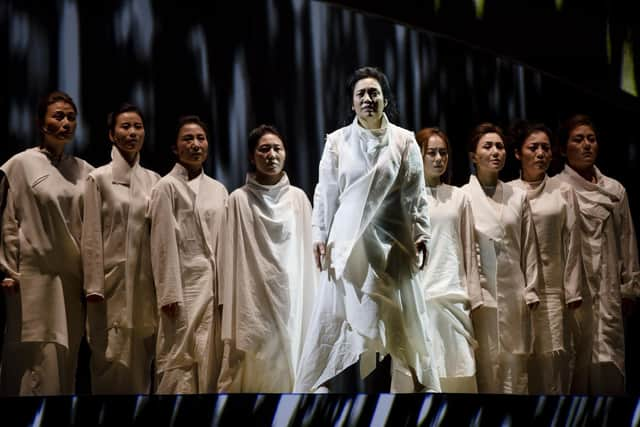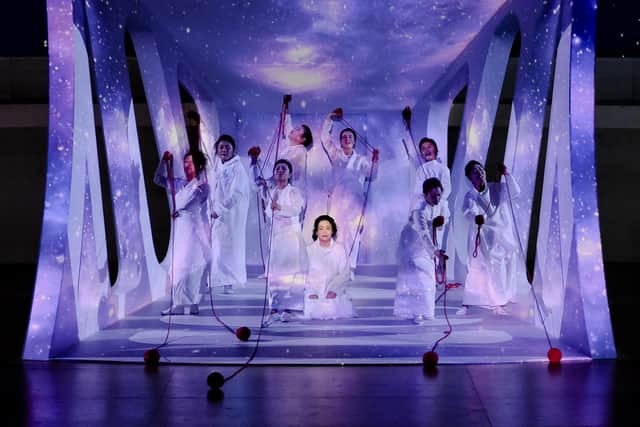Edinburgh International Festival preview: Ong Ken Seng on Trojan Women
A pared-back reimagining of Bartók’s Bluebeard’s Castle might be the Edinburgh International Festival’s lone staged opera for 2023. But – at the risk of offending cultural sensitivities in both Europe and Asia – you could make a strong case that there’s another: Trojan Women. The production’s Singaporean director, Ong Keng Sen, can see certain similarities. “If you take the deep emotionalism in some parts of an opera like Madama Butterfly, for example,” he says, “then you’ll encounter something similar here – but non-stop across the whole show.”
Ong is no stranger to Edinburgh. He first visited the festival with Madame Mao’s Memories at the Traverse Theatre as part of the 1992 Fringe – “we were staying four people to a room back then,” he laughs, “with a one-hour turnaround between shows, and a different time slot every day” – and then Diaspora at the 2009 International Festival.
Advertisement
Hide AdFourteen years later, Ong is now revered as one of Asia’s most perceptive (and sometimes most provocative) stage directors. It’s a reputation that he demonstrated in Trojan Women’s origins. When Ong was approached by the National Theatre of Korea in 2016 to create a new production, his suggestion was to reimagine and rework some of the country’s own hallowed theatrical traditions – namely changgeuk and pansori.


“These are two separate forms, really,” Ong explains. “Pansori is a kind of storytelling performance, with one singer and one instrumentalist. About a century ago, they started making these stories into stage works, called changgeuk, with the characters being performed by individual singers.” Only six full changgeuk works survive, however, as well as seven fragments. No wonder Ong hopes that Trojan Women might eventually enter the regular changgeuk repertoire – which, judging by the show’s international success so far, seems increasingly likely.
It’s in trying to define what changgeuk actually is that comparisons with Western opera become inevitable. For a start, both performance genres are story-led, staged and sung. But Ong sees connections on a more fundamental level. “When you’re working with the traditional artistic forms of any country, you have to locate and understand where the lodestone for expression is. With Korean changgeuk, it’s in a very overt emotionalism – very expressive, very heartfelt.” Indeed, what immediately strikes you about Trojan Women is its gripping, even strident emotion – its grief, its fury, its fatalism – which might feel quite familiar to opera-goers, and which can’t help but draw similarly strong responses from an audience, as Ong himself recalls.
“I can remember rehearsals where everyone was so emotional,” he says, “and it’s a big cast, so the rehearsal rooms are usually very full too. You see singers weeping their guts out, so of course I end up doing the same. Sometimes I might suggest just doing a simple tech rehearsal, so that the performers wouldn’t get too involved or too stressed. But it’s impossible. As soon as they start singing, it’s intuitive – they’re belting it out, and they’re so deeply inside the emotions.”
Ong found a fitting subject for his new changgeuk in the 2,500-year-old play The Trojan Women by Euripides, often considered one of the most powerful anti-war statements in the history of artistic creation. We’re in Troy in the immediate aftermath of the Greek army’s victory in the Trojan War. The city’s men are dead, or have fled. The women, however – among them Hecuba, Cassandra, Andromache and the hated Helen (who, in eloping with Paris, prompted the war in the first place) – await their fates at the hands of the Greek conquerors: they will be forced into slavery, or coerced to become concubines.


Part of the ancient Greek play’s attraction, Ong remembers, was its timeless theme of women as the innocent victims of conflict, cursed to suffer the fallout of wars waged by men. He points to one recent example with particular resonance in Korea: the so-called “comfort women” forced into sexual slavery across Asia during World War II by the conquering Japanese army. “It’s a story that’s still affecting us. I was born in the 1960s, and this was happening just two decades earlier. At the time I was first working on this production, some of the Korean women who were still alive from that time were still fighting for acknowledgement and reparations from the Japanese.”
Advertisement
Hide AdAnd though Ong’s production steers clear of specifically relocating Euripides in the 1940s, the resonances ring clearly. He was aided, too, he says, by the almost operatic structure of the original play. “Each of the central characters appears for about 20 minutes, and is then taken away. So you get a very intense encounter with each character individually – almost like an extended opera aria – before moving on to the next person.”
He was delighted, he says, to be able to draw on the expertise of pansori legend Ahn Sook-sun in creating these aria-like solos. “I first saw her when I was in Korea in 1998 as a young director. She was already something of a legend 25 years ago, but she’s now classed as a Living National Treasure in pansori by the South Korean state.” Rumour has it that Ahn would even cough up blood during rehearsals, rupturing blood vessels in her vocal cords from high-intensity repetitions of the vocal lines. When you experience the intensity of the piece, it makes sense.
Advertisement
Hide AdObserving pansori tradition, most of the characters are joined by a solo instrument from the ten-strong band that accompanies the production. For Helen, however, Ong had something else in mind. “She’s very different from the other women, so I had to find a way to make that immediately recognisible,” he says. “I thought the only way it would work would be if Helen was a man.” Accordingly, for Helen’s musical accompaniment Ong drew on far more contemporary Korean music. “I collaborated with K-pop producer Jung Jae-il – although until I met him, I thought K-pop was all about nubile young boy bands and girl bands doing slick dance routines. But he explained to me that in Korea, all pop was K-pop. He sat down at the piano and just played for me. It was so interesting to hear this deep emotion in the music, which is exactly what I was looking for.”
The result is a startling collision of ancient Western drama with deeply felt Asian theatre, searingly intense traditional music and no less emotional pop. And it’s a production whose ideas of female solidarity offer a revealing perspective on the International Festival’s theme of community over chaos.
As well as much-praised performances in South Korea, Trojan Women has travelled right across America and Europe before its Edinburgh outings. It’s so well established, Ong says, that his performers have become something of a company within a company – even, maybe, a family. “It’s been in the National Theatre of Korea’s repertory for seven years, and it’s survived the pandemic. But every time we perform it, we gather the team of 25 performers for two full weeks of rehearsals. It’s a lot of work – but then, you can see all that work on the stage in front of you.”
Trojan Women, Festival Theatre, 9-11 August